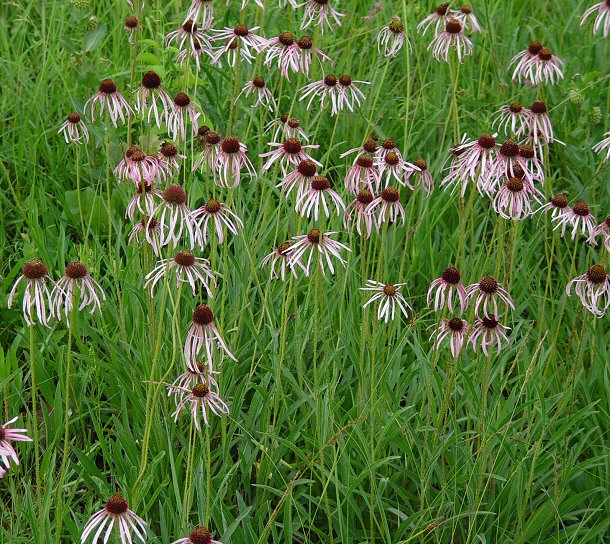Echinacea pallida (Nutt.) Nutt.
Pale Purple Coneflower

Native
CC = 7
CW = 5
MOC = 70
© DETenaglia
Echinacea pallida (Nutt.) Nutt.Pale Purple Coneflower | |
 |
Native CC = 7 CW = 5 MOC = 70 |
© DETenaglia |
|
Family - Asteraceae/Heliantheae Habit - Rhizomatous perennial forb with a usually elongated, vertical rootstock and often somewhat tuberous main roots. Stems - Erect, to 1.5 m, mostly unbranched, sparsely to moderately pubescent with stiff, spreading, minutely pustular-based hairs. Leaves - Mostly basal, alternate on stem, simple. Blades with the margins entire and usually pubescent with spreading hairs, the surfaces moderately to densely pubescent with stiff, mostly spreading, mostly minutely pustular-based hairs, moderately to strongly roughened to the touch, with 3 main veins. Basal leaves 8-35 cm long, the blade narrowly elliptic to narrowly lanceolate or lanceolate, mostly 5-20 times as long as wide, long-tapered or narrowly angled at the base. Stem leaves 4-25 cm long, linear to narrowly elliptic or narrowly lanceolate, otherwise similar to the basal leaves.
Inflorescence - Single, large flower head terminating stem. Heads - Involucral bracts 7-15 mm long, the outer surface moderately pubescent with mostly pustular-based hairs, not glandular. Receptacle conic, 2-4 cm in diameter, the chaffy bracts 9-14 mm long, hardened, usually dark purple toward the tip.
Florets - Ray florets sterile, the corolla 4-9 cm long, 5-8 mm wide, reflexed or drooping at flowering, pale pink to pink. Disk to 3 cm in diameter. Disc florets with the corolla 6-8 mm long, the tube yellow to green, the lobes pink to dark purple. Stamens 5, adnate to the base of the corolla tube, included. Pollen white when fresh.
Fruits - Achenes 2.5-5.0 mm long. Flowering - May - July. Habitat - Upland prairies, glades, savannas, openings of dry upland forests, pastures, railroads, and roadsides. Origin - Native to the U.S. Lookalikes - E. simulata, E. purpurea. Other info. - This iconic species is found throughout most of Missouri, probably more abundantly toward the western side of the state. Its main range is within a band within the lower U.S. Midwest, reaching from Iowa and Illinois down through Louisiana. The plant is fairly easy to identify from its erect, mostly leafless but bristly stems and solitary flowering heads with drooping pale purple rays. However, it is very easy to confuse with E. simulata, as the two have virtually identical appearances. The distinction is easy when pollen is being shed, as fresh pollen of E. pallida is white and that of E. simulata is yellow. Photographs taken near Stegal Mountain, MO., 6-13-05, and off County Road 2010, Lawrence County, MO., 6-16-05 (DETenaglia); also at Ha Ha Tonka State Park, Camden County, MO, 6-2-2012 (SRTurner). |